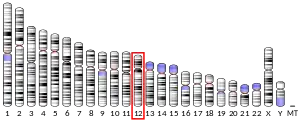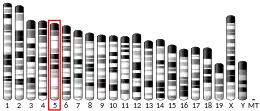Sirtuin 4, also known as SIRT4, is a mitochondrial protein which in humans is encoded by the SIRT4 gene.[5][6] SIRT4 is member of the mammalian sirtuin family of proteins, which are homologs to the yeast Sir2 protein. SIRT4 exhibits NAD+-dependent deacetylase activity.
Function
SIRT4 is a mitochondrial ADP-ribosyltransferase that inhibits mitochondrial glutamate dehydrogenase 1 activity, thereby downregulating insulin secretion in response to amino acids.[7] A deacetylation of malonyl-CoA decarboxylase enzyme by SIRT4 represses the enzyme activity, inhibiting fatty acid oxidation in muscle and liver cells.[8][9] SIRT4 has a suppressive effect on peroxisome proliferator-activated receptor alpha (PPAR-α) which downregulates fatty acid oxidation in liver cells.[9] Deacetylation of ADP/ATP translocase 2 (ANT2) increases cellular ATP by dampening mitochondrial uncoupling.[9]
Clinical significance
SIRT4 is a mitochondrial tumor suppressor protein.[9] Overexpression of SIRT4 inhibits cancer cell proliferation by inhibition of glutamine metabolism.[9][10]
References
- 1 2 3 GRCh38: Ensembl release 89: ENSG00000089163 - Ensembl, May 2017
- 1 2 3 GRCm38: Ensembl release 89: ENSMUSG00000029524 - Ensembl, May 2017
- ↑ "Human PubMed Reference:". National Center for Biotechnology Information, U.S. National Library of Medicine.
- ↑ "Mouse PubMed Reference:". National Center for Biotechnology Information, U.S. National Library of Medicine.
- ↑ Frye RA (June 1999). "Characterization of five human cDNAs with homology to the yeast SIR2 gene: Sir2-like proteins (sirtuins) metabolize NAD and may have protein ADP-ribosyltransferase activity". Biochem. Biophys. Res. Commun. 260 (1): 273–79. doi:10.1006/bbrc.1999.0897. PMID 10381378.
- ↑ "Entrez Gene: Sirtuin 4".
- ↑ Haigis MC, Mostoslavsky R, Haigis KM, Fahie K, Christodoulou DC, Murphy AJ, Valenzuela DM, Yancopoulos GD, Karow M, Blander G, Wolberger C, Prolla TA, Weindruch R, Alt FW, Guarente L (September 2006). "SIRT4 inhibits glutamate dehydrogenase and opposes the effects of calorie restriction in pancreatic beta cells". Cell. 126 (5): 941–54. doi:10.1016/j.cell.2006.06.057. PMID 16959573. S2CID 1391160.
- ↑ Nasrin N, Wu X, Fortier E, Feng Y, Bare' OC, Chen S, Ren X, Wu Z, Streeper RS, Bordone L (October 2010). "SIRT4 regulates fatty acid oxidation and mitochondrial gene expression in liver and muscle cells. In primary myotubes and hepatocytes, knockdown of SIRT4 results in increased Fatty Acid Oxidation, cellular respiration, and pAMPK levels. SIRT4 inhibition increases fat oxidative capacity in liver and mitochondrial function in muscle, which might provide therapeutic benefits for diseases associated with ectopic lipid storage such as type 2 diabetes". J. Biol. Chem. 285 (42): 31995–32002. doi:10.1074/jbc.M110.124164. PMC 2952200. PMID 20685656.
- 1 2 3 4 5 Li S, Zheng W (2018). "Mammalian Sirtuins SIRT4 and SIRT7". Progress in Biophysics and Molecular Biology. Progress in Molecular Biology and Translational Science. 154: 147–168. doi:10.1016/bs.pmbts.2017.11.001. ISBN 9780128122617. PMID 29413176.
- ↑ Yoo HC, Yu YC, Sung Y, Han JM (2020). "Glutamine reliance in cell metabolism". Experimental & Molecular Medicine. 52 (9): 1496–1516. doi:10.1038/s12276-020-00504-8. PMC 8080614. PMID 32943735.
Further reading
- Yamamoto H, Schoonjans K, Auwerx J (2007). "Sirtuin functions in health and disease". Mol. Endocrinol. 21 (8): 1745–55. doi:10.1210/me.2007-0079. PMID 17456799.
- Michishita E, Park JY, Burneskis JM, et al. (2005). "Evolutionarily conserved and nonconserved cellular localizations and functions of human SIRT proteins". Mol. Biol. Cell. 16 (10): 4623–35. doi:10.1091/mbc.E05-01-0033. PMC 1237069. PMID 16079181.
- Reiling E, van Vliet-Ostaptchouk JV, van 't Riet E, et al. (2009). "Genetic association analysis of 13 nuclear-encoded mitochondrial candidate genes with type II diabetes mellitus: the DAMAGE study". Eur. J. Hum. Genet. 17 (8): 1056–62. doi:10.1038/ejhg.2009.4. PMC 2986549. PMID 19209188.
- Gerhard DS, Wagner L, Feingold EA, et al. (2004). "The status, quality, and expansion of the NIH full-length cDNA project: the Mammalian Gene Collection (MGC)". Genome Res. 14 (10B): 2121–27. doi:10.1101/gr.2596504. PMC 528928. PMID 15489334.
- Ahuja N, Schwer B, Carobbio S, et al. (2007). "Regulation of insulin secretion by SIRT4, a mitochondrial ADP-ribosyltransferase". J. Biol. Chem. 282 (46): 33583–92. doi:10.1074/jbc.M705488200. PMID 17715127.
- Sanger Centre, The; Washington University Genome Sequencing Cente, The (1998). "Toward a complete human genome sequence". Genome Res. 8 (11): 1097–108. doi:10.1101/gr.8.11.1097. PMID 9847074.
- Frye RA (2000). "Phylogenetic classification of prokaryotic and eukaryotic Sir2-like proteins". Biochem. Biophys. Res. Commun. 273 (2): 793–98. doi:10.1006/bbrc.2000.3000. PMID 10873683.
- Irobi J, Van Impe K, Seeman P, et al. (2004). "Hot-spot residue in small heat-shock protein 22 causes distal motor neuropathy". Nat. Genet. 36 (6): 597–601. doi:10.1038/ng1328. PMID 15122253.
- Strausberg RL, Feingold EA, Grouse LH, et al. (2002). "Generation and initial analysis of more than 15,000 full-length human and mouse cDNA sequences". Proc. Natl. Acad. Sci. U.S.A. 99 (26): 16899–16903. Bibcode:2002PNAS...9916899M. doi:10.1073/pnas.242603899. PMC 139241. PMID 12477932.
- Scherer SE, Muzny DM, Buhay CJ, et al. (2006). "The finished DNA sequence of human chromosome 12". Nature. 440 (7082): 346–51. Bibcode:2006Natur.440..346S. doi:10.1038/nature04569. PMID 16541075.
This article incorporates text from the United States National Library of Medicine, which is in the public domain.



